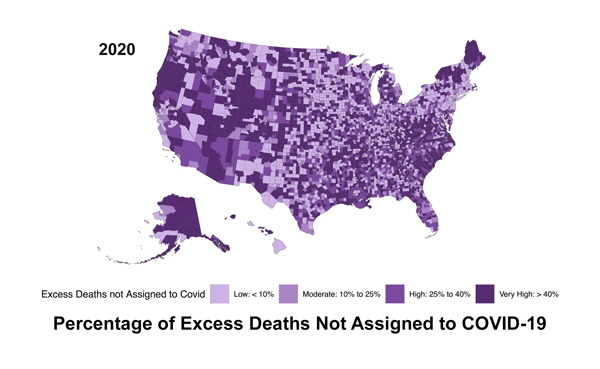New County-Level Estimates Reveal 170,000 Hidden US COVID-19 Deaths Between 2020-2021.

New County-Level Estimates Reveal 170,000 Hidden US COVID-19 Deaths Between 2020-2021
A new analysis led by Andrew Stokes, indicates that nearly 940,000 people died in the US beyond expected totals in the first two years of the pandemic—and more than 18 percent of these deaths were not counted as COVID-19 deaths.
As the United States nears the once-unfathomable milestone of one million confirmed lives lost to COVID-19, a new study by researchers at Boston University School of Public Health (BUSPH), The University of Pennsylvania (Penn), and the Robert Wood Johnson Foundation (RWJF) has found that this staggering death toll is at least 22 percent higher than official Covid-19 death tallies reveal.

Available as a preprint on MedRxiv ahead of peer-reviewed publication, the study examined excess deaths—a metric that captures the number of deaths in a crisis above and beyond what would be expected in normal times—in 3,127 US counties between March 2020 and December 2021. The researchers found that a total of 936,911 excess deaths occurred in the U.S. during this period, and 171,188 (18.3 percent) were not counted in official COVID-19 death tallies.
The study is the first comprehensive assessment of excess COVID-19 mortality in the US in 2021; prior studies have focused on excess mortality in 2020.
The findings paint a clear picture of the changing geographic patterns of mortality across counties, regions, and urban-rural areas throughout the pandemic. While COVID-19 deaths in 2020 were more pronounced in large, urban areas in the Northeast, Far West, Southeast, and Southwest, the mortality burden shifted sharply to rural areas, especially in the Southeast and Southwest during 2021.
The mortality impact of the pandemic is still effectively hidden in many parts of the country.
Examining excess deaths by county reveals patterns in mortality not discernable at the state level and captures the mortality impact specific to local communities. It can also identify places where the mortality impact of the pandemic has been hidden. These hidden deaths include uncounted COVID-19 deaths that were assigned to another cause, as well as indirect deaths that occurred due to other pandemic-related factors, such as limited healthcare access, increased substance use, and other social and economic hardships.
“These new estimates are our best guess at the true impact of COVID-19 across US communities,” says study corresponding author Andrew C. Stokes, assistant professor of global health, who has studied excess deaths closely throughout the pandemic. “While the total number of hidden deaths decreased from 2020 to 2021, the mortality impact of the pandemic is still effectively hidden in many parts of the country, especially in rural areas and in the South.”
“This research makes clear that the pandemic is far from over, and state and federal governments’ focus on individual behaviors instead of population-level measures like paid family and medical leave, universal health care, and targeted vaccine delivery campaigns for the communities most impacted has had severe consequences,” says study co-author Dielle Lundberg, research fellow in the Department of Global Health.
The team’s previous research, along with an investigative reporting collaboration with USA Today, suggests that the underestimated official COVID-19 death counts are, in part, a product of the country’s flawed death investigation system. Pandemic-related deaths are only recorded as such if COVID-19 is listed on a death certificate as the official cause of death. Death investigation processes vary widely from county to county—particularly in rural areas, where the investigations are often led by inexperienced, politically appointed coroners or Justices of the Peace, who may intentionally and unintentionally bungle the examinations and fail to label COVID-19 as the official cause of death.
Families who have loved ones to COVID are eligible for up to $35,000 of FEMA assistance if COVID-19 is listed on the death certificate, Stokes says. “But there are a lot of applications being denied because the certificate lists other causes of death. It’s a real issue.”
Another reason behind the underreporting of COVID-19 deaths is a lack of testing, says Stokes, noting that in certain areas, testing has been limited throughout the entire pandemic. “We’ve seen a decline in PCR testing, and testing capacity and infrastructure. The rapid tests that individuals take themselves are not necessarily being relayed to a medical professional or certifier, and the positive cases that unfortunately turn into deaths may not contribute to the official death tallies.”
A geographical snapshot of excess mortality by COVID-19:
- Among the top 20 counties with the highest death undercounts in 2020: Pontotoc County, MS; Washington County, NY; and Scioto County, OH.
- Among the top 20 counties with the highest death undercounts in 2021: Shelby County, TN; Calloway County, KY; and Lafayette County, LA.
- In 2020, there were uncounted COVID-19 deaths in the majority of counties in all regions, except New England.
- In 2020 and 2021, Mississippi and Arizona were among the top 5 states with the most uncounted COVID-19 deaths.
- In 2020 and 2021, Massachusetts was among a small number of states with no uncounted COVID-19 deaths.
At SPH, the study was also co-authored by Rafeya Raquib, MS student and graduate research assistant in GH, and Jacob Bor, assistant professor of global health and epidemiology. Additional authors include lead author Eugenio Paglino, and co-authors Irma T. Elo and Samuel H. Preston, all of the Department of Sociology and Population Studies Center at Penn; and co-authors Ahyoung Cho, of the Department of Political Science at BU; and Joe A. Wasserman and Dr. Katherine Hempstead of RWJF.
Other contributors to the project include Nahid Bhadelia and Erica Augustine from the Center for Emerging Infectious Diseases Policy and Research (CEID) at Boston University and Elif Coskun, Mikas Hansen, Sylvia Lutze, and Steele Myrick, all MPH/MS students at BUSPH and graduate research assistants in GH.